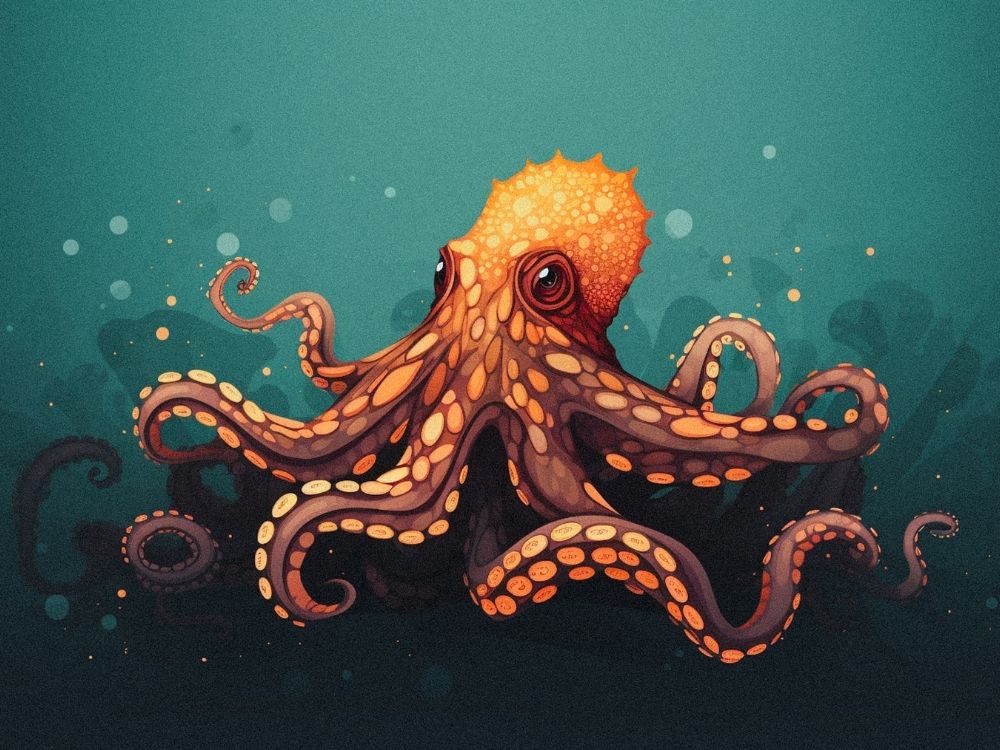The Wheel and the Spokes
The traditional image of the Eightfold Path is a great wheel with eight spokes. When all the spokes work together, the wheel turns smoothly. When one is missing or weak, the wheel wobbles — a fitting representation of dukkha (suffering).
In the Buddha’s time, the wheel was still a relatively new invention, only about a thousand years old, and it had already transformed human life. Using it as an image for the path carried enormous meaning.
Meeting My Octopus Teacher
After watching My Octopus Teacher, I began to see octopuses differently. My feelings toward them and the world they inhabit deepened — and I heard many others say the same. Their existence became illuminated in a way I hadn’t considered before.
So it feels fitting to hold the Eightfold Path alongside this modern-day representation: the octopus. Its many arms, its intelligence, and its way of moving through the world can help us better understand the Path we walk.
Eight Arms, Nine Brains
An octopus has eight arms — and each has its own brain. Along with the central brain that works with the eyes, each arm has a kind of wisdom and agency. They can think, feel, and move independently, while also cooperating with each other.
The arms touch, intertwine, and support one another. They enhance each other’s movements. Sometimes one leads, others help, and some simply stand by. This is not so different from the Eightfold Path: the spokes are mutually supportive, sometimes one takes precedence, sometimes another.
The Eight Arms of the Path
The Eightfold Path is often described in these terms:
- View
- Intention (or imagination)
- Speech
- Action
- Livelihood (or survival)
- Effort
- Awareness
- Concentration (or inward collectedness)
Like the arms of the octopus, each represents an aspect of the path. Each develops in its own unique way, but always in relationship to the others.
The Attitude of Samma
Before each element of the Path, the Pali word samma is placed. It’s been translated many ways: wise, useful, right, appropriate, helpful, skillful.
We consider it in a slightly different way: as an attitude of care.
Rather than striving to be “right” or even “wise,” we might bring an attitude of care to our intentions, to our actions, to our views. This attitude colors everything we do.
Care is a rich word in Buddhist literature. It’s the opposite of recklessness or neglect. It contains thoughtfulness, curiosity, and consideration. When care is absent, things fall apart. Negligence reduces complexity and increases harm.
A GPS of Care
You might think of this attitude as a kind of “care GPS.” It helps guide us toward what is ethical, virtuous, and ennobling.
The path is not pristine. There are bumps, kinks, and detours. We make mistakes, sometimes falling into negligence, but through refinement we adjust our compass.
Like the octopus — mysterious, resilient, and adaptable — the path is alive, complex, and always unfolding.
A Ritual of Reflection
We invite you to take a few minutes to sit in meditation with this teaching, if you wish. Afterward, you may find it helpful to journal.
✨ What are your thoughts and feelings on this topic?
✨ Is this something you would like to contemplate in meditation?
✨ Where do your thoughts and feelings go after reading this?
✨ Ritual of Reflection: How did that land for you?
About the Daily Online
This reflection comes from one of our Daily Online sessions, held every day from 9:00–10:00 AM PT. Each gathering begins with a short dharma talk, followed by meditation, journaling, and a chance for shared conversation with the teachers.
In Reflective Meditation, we encourage approaching practice with gentleness, kindness, and curiosity. Cameras remain off during meditation so each participant can practice in their own way. Afterward, a few people share their reflections with the teacher of the day, while others observe and learn from the exchange.
Learn more or join us at reflectivemeditation.org/dailyonline.


